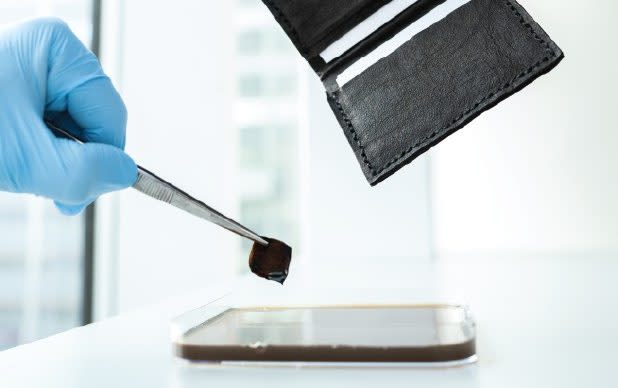A fake leather shoe is grown from bacteria in a lab in 14 days and programmed to dye itself black.
Researchers at Imperial College London (ICL) cultivated the plastic-free vegan creation from genetically engineered microbes.
This is the first time bacteria have been designed to produce matter and their own pigment at the same time.
Researchers believe the process could be adapted to produce vegan materials with vibrant colors and even patterns, and to offer alternatives to fabrics such as cotton and cashmere.
Professor Tom Ellis, lead author from ICL’s bioengineering department, said: “Inventing a new, faster way to produce sustainable, self-dyed leather options is a major achievement for synthetic biology and sustainable fashion.
“Bacterial cellulose is essentially vegan, and leather requires a fraction of the carbon emissions, water, land use and time of cow farming to grow.
Unlike plastic-based leather alternatives, bacterial cellulose can also be made without petrochemicals, and will biodegrade safely and non-toxic in the environment.”


Manufacturers are trying to move away from synthetic chemical dyeing because it is toxic to the environment. The black dyes used to color leather are extremely harmful.
The self-dying leather option was created by modifying the genes of a bacterial species that produces sheets of microbial cellulose – a strong and flexible material already commonly used in food, cosmetics and textiles.
Genetic modifications “directed” the same microbes that were growing the material to also produce a dark black pigment called eumelanin.
The cellulose was grown around a shoe-shaped mold to give it a traditional ‘upper’ shape and after 14 days it took the correct shape.
To encourage the shoe to turn black, it was gently shaken at 30C (86F) to activate the production of black pigment from the bacteria to dye the material from the inside.
The team, who worked with London-based biodesign company Modern Synthesis, also made a black wallet by growing two separate sheets of cellulose, cutting them to size and sewing them together.
Co-author Dr Kenneth Walker, who carried out the work at ICL and now works in industry, said: “Our technique works at scales large enough to create real-world products, as our prototypes demonstrate.
“From here we can consider aesthetics as well as other shapes, patterns, textiles and colours.
“The work also shows the impact that can occur when scientists and designers work together. As current and future users of new bacteria-grown textiles, designers play a key role in promoting exciting new materials and providing expert feedback to improve form, function and the transition to sustainable fashion.”
In addition to the prototypes, the researchers showed that the bacteria can be engineered using genes from other microbes to produce colors in response to blue light.
Colored proteins are produced
By projecting a pattern, or logo, onto the sheets using blue light, the bacteria respond by producing colored proteins that then light up.
This allows them to project patterns and logos onto the bacterial cultures as the material grows, creating the designs within the material as a result.
The research team is now experimenting with a variety of colored pigments to use those that can be produced by the microbes that grow on the material.
Professor Ellis said: “Microbes are already tackling many of the problems associated with animal and plastic-based leather directly, and we plan to get rid of them by expanding into colours, materials and b maybe new patterns too.
“We look forward to working with the fashion industry to make the clothes we wear greener throughout the entire production line.”
The research was carried out in conjunction with Modern Synthesis, a London-based biodesign and materials company specializing in innovative microbial cellulose products. It was published in the journal Nature Biotechnology.
Other options must be desirable as well as green
By Stephen Doig
The rise of vegan and lab-grown alternatives is nothing new, but it’s encouraging that the movement is gaining ground among established fashion brands and emerging businesses. These new offerings are remarkable as they push the boundaries of science but are you willing to spend them?
It is a trivial matter; how to tap into that all-important greed with a conscience how do you do it. Stella McCartney has been one of the most vocal advocates of alternatives to animal-derived materials and synthetic materials and her version of “leather” came from Mirum, a hard-wearing product made from natural rubber.
Our grandmother was in fur
Animal agriculture is responsible for 18 percent of the world’s greenhouse gas emissions, and while much leather is a by-product of farming, there is a clear need for more sustainable methods. A forecast from a 2023 report predicts that cell cultured leather is expected to grow from a $4.05 million business in 2022 to $8.15 million by 2030, so there is clearly a movement – especially among the new generation of consumers – to develop do the way we create such accessories. such as shoes and bags.
Our grandmothers may have been in furs and diamonds (only ethically), but their Gen Z offspring may be in bacteria-cultured backpacks (not so glamorous, is it?)
The self-dyeing element of this new vegan leather is an interesting development; the dyeing and tanning process usually involves chemical processes and a lot of water. Global brands such as Zegna, for example, focus on a natural dyeing process, taking advantage of materials from local flora and fauna.
But there is a a lot of green-washing when brands claim to have proven sustainable and ethical practices in sourcing alternatives to animal products – look at the fur of fake fur being filled with toxic microplastics.
The aesthetics of the prototypes from ICL may be a bit challenging – the shoe could almost be a Rick Owens Paris catwalk push but it’s not exactly mainstream. However, the spirit is noble. It’s a step – no pun intended – in the right direction.